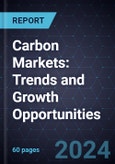Carbon Pricing Operates as an Instrument to Tackle Emissions and Accelerate the Transition to Net Zero
Carbon markets are trading systems that use greenhouse gas (GHG) emissions as a commodity, setting a price on them based on the value of the emitted carbon dioxide. Companies can purchase and sell carbon credits or carbon offsets to compensate for their GHG emissions. There are two main types of carbon pricing initiatives, mandatory and voluntary, resulting in two types of carbon markets, mandatory carbon markets (MCMs) and voluntary carbon markets (VCMs).
Carbon markets are a cost-effective way to reduce GHG emissions and support sustainability drives. Evolving carbon pricing initiatives, both mandatory and voluntary, are expected to make a significant contribution to helping governments and corporations across the world achieve net-zero targets as the deadlines to meet them get closer. Estimated at $821 billion in 2023, the carbon market is set to reach $1750 billion by 2030. MCMs will expand in both size and sector coverage due to increasing demand and new government regulations.
This study delves into the mechanics of MCMs and VCMs, analyzing the factors that drive their expansion and the barriers that restrain their growth. The study identifies the growth opportunities emerging from the changes in this space and outlines key initiatives, prominent players, and noteworthy projects. It analyzes the prevailing trends reshaping the landscape (such as the convergence of MCMs and VCMs, the use of digital technologies, and the shift from nature-based to technology-based credits) and forecasts the trajectory of the market, projecting its evolution up to 2030.








